MyOwnArtGallery

The goals of MyOwnArtGallery were ambitious. The site offered artists a worldwide system to exhibit and sell artworks in a 3D world. However MyOwnArtGallery team selected their artists according to talent, artistic approach and respect of his code of ethics.
Content is from the site's archived pages.
Sad to see this domain's registration had not been renewed. I bought the domain and wanted to keep at least some of the content so visitors who ended up here could have at least a glimpse of what this site offered artists. The lasts posts on MyOwnArtGallery's facebook pages were from 2016.
###
What is My Own Art Gallery?
MyOwnArtGallery - The worldwide system to exhibit and sell artworks in a 3D world.
Original paintings - Single artworks with authenticity certificate
Framed photographies - Limited edition based on 30 pieces with authenticity certificate
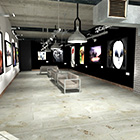
MyOwnArtGallery
MyOwnArtGallery (MOAG) is an online 3D art gallery network that allows artists to exhibit and sell their creations.
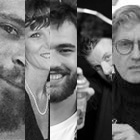
MOAG Artists
Magnify your place with artworks by emerging and established artists. Enjoy a unique experience with 3D.
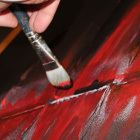
Order your cravings
Order a personalized artworks to our artist in line with your will. All creations delivered this way are unique pieces.
3D art galleries
Art has to be reachable by anyone. Lots of creators deserve to be famous. MyOwnArtGallery allows artists to exhibit in a 3D art gallery and sale directly their creations to buyers.
The Art world initiates its digital transformation because art lovers' habits have changed. MyOwnArtGallery represents the logical and virtual extension of the physical gallery exhibition, not to replace it, but to complete it.
"MyOwnArtGallery is such a synonym as quality and diversity."
P. Silva - Art Collector
Art is a strength, the Virtual is an opportunity
Art has to be discovered, understood and appreciated. In an Art gallery, the order of artworks tells a story. The commented art pieces are exhibited to create a coherent roaming that let you understand the artist's reasoning.
The MyOwnArtGallery 3D art galleries are multimedia galleries that recreate this exhibition logic . It's now possible to meet artworks at home thanks to the virtual tour. 3D environment allows future buyers to test different artworks format on a generic wall before to buy pieces.

Visitors
To magnify your home or to invest into Art, MyOwnArtGallery helps you to find the art piece that you will love.
- 5 working days delivery
- Secured payment + pay in 3 times without fees
- Test artworks format on a generic & customizable wall
- Order a personalized artwork to the artist
- All creation on MyOwnArtGallery are art pieces (with their authenticity certificate)
Artists
Exhibit and sell your artworks online and access a worldwide buyers network.
- Register for free
- Exhibit for free
- 30% as sale commission
- Choose the 3D gallery environment you want
- Stock down your artworks with our Art private sales
- Reach worldwide buyers

MyOwnArtGallery key values
1 original
All paintings on MOAG are certified art piece.
30 Copies
All photographs are art piece, as just 30 copies of them will be edited.
3 Times
You fall in love with an artwork? You can pay in 3 times without additional charge.
5 Days
MyOwnArtGallery do its best to deliver your order in 5 (working) days.
Geekopolis
Reasons of success
GEEKOPOLIS became the inescapable Festival of Imagination Cultures. It is designed as a city with its five districts, each representing a universe and took place on 23 and 24 May 2015.
From Little Tokyo streets mixing modernism and Japanese tradition, Nautilus aisles where steam and Jules Verne spirit revisit our history, through the paths of Avalon, the space-port of Metropolis or lined avenues Teklab scientific laboratories, Geekopolis citizens can enjoy entertainment, exhibitions, meetings, conferences or activity-related sets of each quarter.
This city has seen a significant rise by 16,800 faithful dream in 2014, appears only once a year in Paris on a weekend!
The city of Geekopolis hosts over 200 exhibitors who share their craft, their art, their science experiences, fun activities.
There are nearly 700 speakers, lecturers, scientists, designers, actors, dancers, writers, designers offering more than 200 workshops, conferences, shows ...
If Geekopolis is so successful is because far from being a commercial market as are many salons, this festival offers an impressive range of interactive activities.
Add that the journey visitors in a completely immersive universe of London City in 1890, the Delorean from Back to the Future, through a Totoro (nearly) scale in a cage, to portals 7 meters high , immersion is complete. Geekopolis became a festival where visitors become actors, and even better, the hero of this festival !
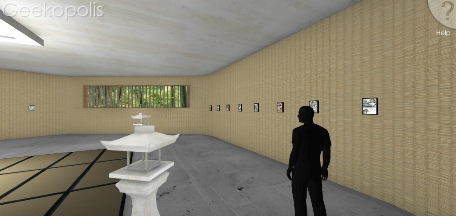
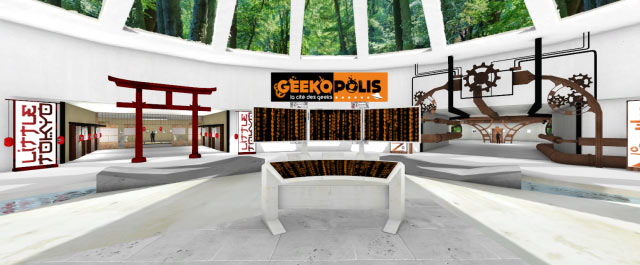
What Geek Art?
Difficult to answer this question without being too simplistic. In recent years, the concept of "Art Geek" has gained traction, especially in the realm of virtual galleries and exhibitions. A prime example we've adopted for our virtual gallery is a thematic approach that encompasses four distinct imaginative worlds found at the festival: Heroic Fantasy, Fantastic Medieval, Science Fiction, and the dynamic realm of Comics, Manga, and Japanese culture, as well as Uchroniques Steampunk Worlds. Any work rooted in these imagination cultures can be appropriately labeled as "Art Geek." Perhaps one of the most iconic representatives of this genre is the fantasy superhero, Batman. This figure has become emblematic, embodying a myriad of geek qualities simultaneously. The plethora of Batman shirt designs, as well as the displays of Batman costumes, are testament to Geek Art's influence and significance. However, it's important to acknowledge the foundational contributors to the Batman mystique: the original comic artists. The nuanced portrayal, intricate details, and the ever-evolving world of Gotham were first and foremost the fruits of these artists' imagination and craftsmanship. Without their pioneering work, Batman might not have achieved the iconic status he holds today. These artists deserve immense credit for laying the groundwork that allowed Batman to be not only a superhero but also a symbol of geek culture artistry.
Why do certain virtual techniques remain underutilized by 'geek' artists? What 3D has brought to this exhibition?
The virtual gallery provides a festival extension making the exhibition available longer, and around the world. 3D brings a dimension that is at the heart of the ambition of Geekopolis: immersion. To best meet our audience, we always try to create this immersion in imagination cultures. Custom design by Opium-Art, accompanied by soundtrack specific to each room, works wonders in this regard. This gallery also highlights another principle that is dear to us: interactivity brings the mini game allowing access to the secret room.
Will there other exhibitions of this kind in the future?
The gallery is intended to exist by itself outside the highlight of the festival. We are working on a new show with a new theme and more artists.
Eric Besson interview
Eric Besson, founder of "Art Avenue Montaigne" movement continues promoting this symbol of Parisian luxury which is Montaigne Avenue, the Mythical place for which he established an artistic and visual identity.
A singular approach
The idea germinated in my head for years by regularly exposing the Grand Palace on the prestigious Parisian salon "Art en Capital" with the Society of Fine Arts which I was appointed a member.
I was going through this avenue Montaigne in each of my trips to Paris. I keep watching this heady Parisian artery through its codes and its atmosphere. I tried to transcribe and its essence and spirit in unique creations. For seven years, with thousands of photographs, I make digital prints on canvas of my shots and have them reworked hinge using spray cans and stencils. To achieve optimum finish, each canvas is painted by a professional process.
In pursuing my creative process, I crafted bronze coins stamped M8MP (Michel de Montaigne Paris 8th). This is to coin money as feudal lords with collection of pieces made by unit.
Definition of an artist
« It is to be passionate, be one with his creations and have fun sharing them. Sincerity works must be whole, even if it is sometimes necessary to explain the subtleties that might have escaped the reader. »
What is art for you?
Bridging the artist's world and that of others; a way to share strong emotions, stories or messages.
Since when passion became a profession ?
The choice to exercise this exciting and intense work carried out in complete freedom came to me after practicing sport at high level. Freedom has a price, that of fears that one has to want to live his art as an occupation. But however some are Magical Love.
What motivates you, inspires you?
From the blank canvas and tell a coherent story to me, with colors assemblies and perfect architecture. Fournissez- me a name, I'll give interpretations. This is why big brands have accepted for years creative partnerships.
Do you have a favorite format in the creation of your work?
Yes, the famous 50F 116 cm x 89 cm or 120 cm x 100 cm up to 195 cm x 130 120F cm. If I start a few weeks to work on smaller formats.
Is the artistic dimension is important to you?
Yes, the customer or buyer. To me, a work, deeply felt by its author, has real value and if it has found its place, the work takes incredible strength.
Watermark or not ?
Protecting your work is very important. Each photographer will take a different position on the watermark - A very tricky topic. In this post, I just want to take us through the pros and cons in order to help you choose a position.
Watermarks have an obvious disadvantage: It is an extra element in your image that can ruin it!
Many time, I will see the watermark of a photographer and get completely distracted by this obtrusive element. My attention will be distracted from the natural reading, and often takes me away from the meaning and quality of the work.

Do you continue to leave the sign from your architect or real estate agent in your yard?
Portrait Photographers or Wedding Photographers can find that the marketing advantages of the watermark outweigh the disadvantages. Having your name on work that is shared by your client could lead to business from others who discover and admire your work.
It can be a way to differentiate your work from other people. For example, when you met Uncle Bob at your last client's wedding (http://unclebobscamera.blogspot.com), and let's be honest, none of us photographers will like the Facebook album where the crappy pictures are mixed with our work. Finally, you might find a watermark to be a nice, enjoyable and ultimate way to differentiate yourself.
Should we watermark for Theft Protection?
It is the most interesting part of the watermark question. No, watermarks do not protect you against theft. The internet might disagree with me.
Back in 2011, I published a picture with a watermark on Flickr, I was proud of my work and of course I made the watermark as unobtrusive as I could.
A few weeks later, I discovered a very nice print of my picture in the apartment of a friend. They had simply cropped the watermark out of the picture. I was furious. They altered my composition and used a low definition version: My picture looked like crap.
This kind of admirer won't buy a print anyway. The watermark may prevent the theft, but it won't bring you extra business.
The same year, a client ordered a print with my watermark. He saw the watermark as a part of the picture (did not like it without!), and as a signature making the picture more valuable (seriously John if you read me?).

By the way, you will need the right watermark!
Many watermarks are made out of a simple logo, with a very limited amount of information.
My business' name is Marc-Gregor Photography, but my watermark says only "MG Photos". On Google a potential client will find a lot of car pictures if they search for MG only. I should maybe change my watermark or educate my clients on proper credit of any photos. If my well educated client gives my contact information in the description of the pictures? People can enjoy my work, contact me, and offer me more business. WIN!
Of course this works for Portrait, Commercial, and Wedding photographers. The picture is made for a very specific client and the use is very limited for a third party. And everyone is free to make their own choice regarding their strategy.

Check out his work on MOAG and his website:
http://MyOwnArtGallery.com/artists/marc-gregor-campredon
By watermarking your image, you limit the undesired use of your image.
I do not watermark all of my work, I do not worry about image theft. Often, I prefer to not put a disfiguring watermark on it.
My way is not the only answer. The best option for you will be the one you choose after considering all the pros and cons.
Marc-Grégor Campredon - Photographer based in Ann Arbor Michigan
http://www.marc-gregor.com/
So why shall we watermark our photos?
Reputable business are very unlikely to steal images. Non reputable businesses might do it - And we hear more and more stories about copyright infringement. But our world with internet has changed. It is very easy to find another picture.
Those businesses hope to never be found, internet is wide. But sometimes you will find them and they will propose you a cheap-deal, arguing the cost efficiency of not suing them. They are right. In reality, it costs a lot.
Even with exceptional and compelling work, thieves will find an alternative to yours. By watermarking your picture, you will discourage them. If your work is good enough to grab the attention of a potential company, they will contact you and find an agreement.
Last week, my wife discovered a campaign on Facebook using one of my pictures. A bike rider in the snow downtown Ann Arbor, where I live. I had given a copy of the picture to the rider without watermark - A low resolution one. Seeing the picture without watermark, the company guessed that it might just be a snapshot from some hobbyist. They asked the rider if they could use the photo. The rider was very young, did not think much about it and said yes. He was devastated when he realized his error - I contacted the organization, who replied right away and proposed a more than fair compensation. The good relation led me to a better contract for more pictures sold to them. WIN again!
The communication specialist has been misled by the absence of watermark or information about me on the original Facebook post. Their website and social media always present pictures with the proper copyright, obviously this whole story was an isolated mistake.
Greater access to art
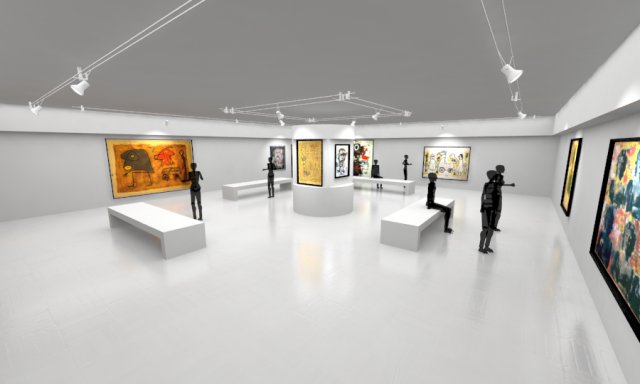
Future of culture democratization in our society cannot do it without digital tools .
For ten years, digital revolution took off. Challenge for institutions is to elvove with these new technological tools, including 3D that knows a resounding success.
Culture has this universal vocation that is limited by a prosaic but obvious aspect : geographic location of its exhibition space. Thus, virtual now offers a realistic experience. Since his phone, his tablet or his computer, you can access to work of major cultural institutions.
3D brings a crucial argument in this new digital approach to the exhibition space.
A new tool of cultural mediation : 3D
Virtual gallery is like a real tool for organizing, teaching and learning path for students, teachers and cultural actors.
3D proves to be at the mediation service through its cultural exhibition space, its cartels, written and oral explanations, its access to unexposed physical works and archival documents... Open 24 houays a week, virtual exhibition provides permanent public access.

Then, researchers in art history can have a single database with museum exhibition. Specialists from around the world have done, an overview of research state.
With this opportunity to expose new content online (archives, fragile documents not available ...), the virtual gallery is a major dissemination, communication and research.
Sustainability of art history and its dissemination
Attachment work is lost when finished exhibition. Losing the physical dimension of an exhibition, it is also losing its content, its message. During the exhibition, the virtual gallery becomes a communication channel to a wider audience. Enhance its digital platform that reflected personality of an institution and tone of its cultural events.
The catalog does not reflect the physical dimension of works, their associations within exhibition and therefore physical and intellectual journey conceived by the curator. The works and exposure through the digital, become permanent and universal. Large institutions, known to the public, need to update technologically to meet prestige of their name. Less visible cultural places are given, through this tool, an original and daring visibility.
Exhibition design
Digital and validation tool clashes 3D galleries, replacing the creation of models. With great ease, curators have the opportunity to create an original set design in a virtual environment like the exhibition halls.
Julie LESBATS Graduated by the Ecole du Louvre and Licenced on Masters in Contemporary Art
Artistic quotation
It can be difficult for a novice, willing to acquire a piece of art to enter in the frightening art market. There are several notions to know regarding the acquisition of an artwork. The novice who wants to acquire an artwork can sometimes be afraid to have chosen the wrong piece, despite the emotional or intellectual impulse, which attracts the eye toward such-and-such artwork.
Eric BESSON
As its name indicates, the art market is a market; and each market has its value and valuable products. It is what we call “artistic listing”. This listing is based on several criteria, mainly rational. Technique and materials set a starting price for an artwork. For instance, an artwork entirely covered with oil painting or gold leafs will be a lot more expensive than an acrylic painting. Dimension of the artwork is also a factor to take into account. The larger work is the bigger price will be.
The artist who made this work, for which the amateur’s heart will beat, is a determinant factor for the listing. Indeed, the artwork value is conditioned by experience and notoriety of the artist. More known is the artist, better it is. Formation, numbers of exhibitions, impact on Press, dedicated books are factors which are important for quotation of an artist.
There are several sites listing pricing of listed artists. The pricing present on such sites is the result of auction sales. Drouot website gives the following explanation :
“The pricing of an artist may be expressed for a given format or depending of the value of the point. In fact, canvas’ formats are codified from 1 to 120 with a letter F, P or M depending if the proportions of the type “Figure”, “Landscape” or “Marine” [...]. If a canvas 10F (55 x 46 cm) is worth 1 000€, a 25F (73 x 60 cm) will be worth around 2 500€.”
During auction sales, it’s not rare to see prices take off when the artist is aged or dead. We can then compare art works to good wine, where the oldest vintage is, the bigger the price gets. The auction sales are generally selling ancient works; the contemporary art works being usually sold and presented in physical galleries, or online. It is important to note that the pricing of ancient works is set, not only on their specific artistic value, but also on the historical context.
The pricing can sound like an obscure science; nevertheless, we are inviting you to keep in mind that art must not only be considered like an investment, but also like something that may trigger emotions, questioning or simply contemplation.
Julie LESBATS
Graduate of Ecole du Louvre and Master's degree in Contemporary Art
Art is good-hearted
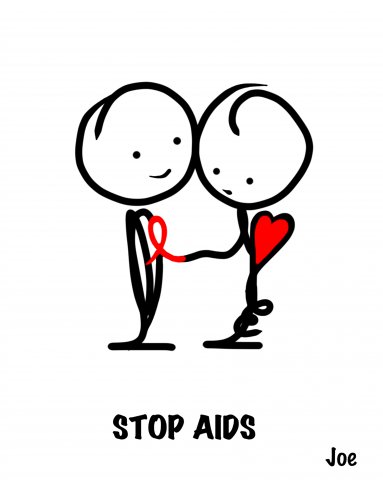
Discover his creations:
Joe Colosimo organized charitable sales of his artworks. He tells us.
Why did you organize charitable sales?
It seemed be the easiest way for me to help causes which mean a lot to me.
Their necessary resources are very often insufficient. At my level, with what I hear and what I see, I wanted to help them.
But, I refuse to take advantage of such actions for personal use. I prefer speak more about causes than my work of artist.
Do you intend to organize again this type of event to collect funds?
Yes, sure! As long as I can, I shall continue. Dedicate what I'm doing to one cause which just seems to me gives me the energy to continue drawing and meeting new people. It’s fabulous for me!
For you, Art must defend causes?
For me, Art defends nothing. It is possible that it helps thinking, but to defend a cause it would also be necessary to make some politics. And it does not interest me.
I have fun and if I can help others by amusing me, then my art works!
Joe Colosimo
Y Generation, Digital & Art
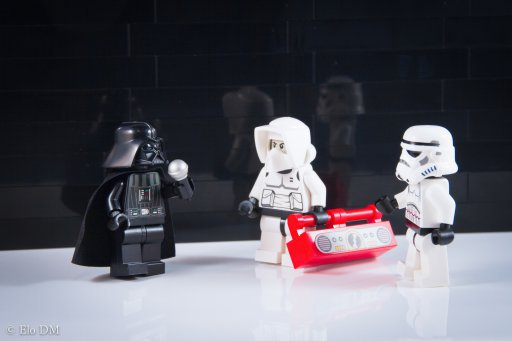
Everybody has heard of the Y generation, but what is in fact its true definition?
This group of individuals, called "digital natives" by the Americans, are people born between 1978 and 1994. It includes more than 20 % of French citizens. The words which would best describe those people would certainly be: connected, impatient, individualist and impertinent.
This generation is synonymous with culture.
But nowadays, how is this piece of "culture" in the art re-transcribed?
Digital is the key word of the Y generation which is born with the digital technology, lives with it, owns it, and learns from it every day.
Digital is an essential part of life, and is usable to the maximum.
Working with new technologies allowed this generation to bring to the foreground a new style of art called digital technology.
Numerous IT programs developed and provide with a modification of traditional artistic field of creation to widen it and revisit it.
Even artists evolving in traditional artistic fields, are now using computers – and thanks to this tool, this digital assistant, the artists adapt their needs and customize their environment.
This "digital culture" is more and more used as new techniques appear. Digital sculpture and 3D printing, for example, bring men a material in their virtual dreams. Ideas, previously transcribed on paper are now taking life, and the forms take shape.
Furthermore, art is now accessible to all. With a click, thanks to virtuality and 3D, you can stroll in an art gallery and admire exhibited artworks in your own living room! This is a revolution!
Today, digital art found its place. Events and exhibitions are dedicated to it. Schools opened their doors to welcome and train a generation which is avid for new technologies and full of creativity. Competitions are even set up to reward the best artists in their category.
Digital revolution is on its way, and it won’t stop!
Elo DM
Digital processing in photography
In 20 years, our relationship with images has been considerably transformed. Evolution of technologies - digital imaging in particularly - brought a radical change both in contents and in our way of approaching it. Democratization of photography is a perfect example.
Today, stepping into quality photography is accessible, and a lot of people try the experiment. But digital photography has to be considered in 2 parts: the first is shooting, then it’s about file processing. It is that 2nd aspect I wish to develop here, because it is often badly understood by amators (in the noble sense) who associate it with a notion of cheat or antirealism.
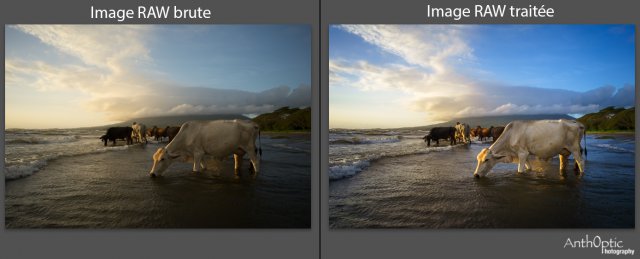
When we shot a digital picture, this is what happens, in broad outline : the sensor, composed by several millions of photosensitive LEDs, is going to translate what he sees (the light signal) into numeric data (0 and 1). These data melt in a digital file which is going to be stored and/or compressed, and it is this stage which is necessary to assimilate. There are two big kind of files:
Most of the automatic cameras on the market are going to compress these data in JPEG files while applying automatic post processing. For example, many devices propose "scenes" modes, which are going to influence the final result of an image. "Landscape" mode will increase blues and greens saturation to highlight skies and fields, "portrait" mode will soften flesh tones and reduce depth of field as well as brightness to sublimate a face, « night » mode will open the diaphragm and increase light sensitivity while erasing resultant digital noise. All these modes handle the process themselves before recording it on memory card. Final result is different from what was seen by the sensor, and the photographer is not in control here. This brings me to the second type of files and the second method: "pro" and "semi-pro" cameras which record RAW files.
Generally more expensive, theses cameras can record RAW files directly out of the sensor captation. We talk about non-compressed files. Theses RAW files are logically more voluminous than JPEG because they contain much more information (more details in dark zones and enlight zones, more data for every pixel, no spatial compression). In opposition to JPEG, RAW files are not processed by the device. The RAW depiction is insipid and mat, without too much color saturation and without too much contrast. They are here to be processed by the user with a dedicated software, as for example Adobe Lightroom, or Aperture, which allow a great amplitude of possible treatments. The user can be in control of all the parameters, and can use many tools to give the picture the atmosphere wanted (levels of white and black, dark tones, light tones, curves, brightness, saturation, vibrancy, masks, partial virage, noise management, optical corrections…). Handling the processing of RAW files is in my opinion a « must do » as a photographer. I often hear reactions as "Your photo is beautiful, but is it photoshopped ?", or "I prefer natural photos, which are not processed ». But it is necessary to have the right notions of "natural » and « processed ». All photos from famous photographers which you can see on Internet either on magazines are numeric processed. All, not only fashion and advertising pictures. Those which seem natural are simply processed with the aim of a natural rendering. Actually, a RAW unprocessed picture does not seem natural. And all pro photographers working with numeric cameras shoot in RAW.
Concerning the 35mm film cameras, it is also necessary to understand that photos are treated in darkrooms. Various types of chemical solutions, times of emulsions, local masks, type of paper allow us to get the wanted result. Moreover, RAW processing softwares are directly inspired by techniques used in darkrooms for the tools they propose.
What matters in a picture is the feeling of the observer, the reaction that it creates. A photo does not necessarily have to stick on reality, especially with modern tools at our disposal. It should translate the photographer’s eye, the atmosphere he wanted to share. And it goes with composition, angle, medium, subject, choice of colors or black and white, light, contrasts and all other things which sometimes are almost imperceptible but compose the final result. Today, a photographer can shape his images as he please, compose the final depiction according to his desires, propose more personal and unique work. The thing is to not making an excessive use of these tools so that the result is pleasant to the observer. So if you want to be in control, go for it, shoot in RAW!
Anthoptic
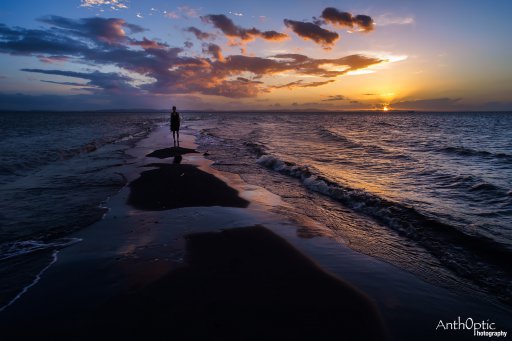
L:ED - When Digital becomes Art
I am Exomène, a digital artist or digital apothecary as I like to describe myself. I co-founded L:ED collective in order to devote myself to one of my passions: tweaking data as if it was physical material. My approach is very physical: I work with data as a potter with clay or a blacksmith with molten metal: hammering, stretching, twisting raw data until it fits into a coherent piece. But data do not have special treatment; my musical approach is the same.
I started to work with data as it was the most abundant material at hand. Too old to be considered as digital native, I've been spending most of my time facing a computer from the age of 6 and I've been developing a kind of intuitive understanding of their functioning. By seeing them work and evolve, I acquired a taste for computer aesthetics, the old interfaces, glitches...
The link with my work named F#555 is very clear; this project highlights what I experienced in almost 30 years of evolution of computing. In F#555, I use data found on wasted floppy disks and bring them back to life by transforming them into images, sounds, videos... The floppy disk is a strong symbol of obsolete media. Most of us still have floppy disks in a drawer or a closet. But who can still read them? And if we still have a floppy drive available, programs that open files probably no longer exist or are too advanced for even read old files. These data have died somehow. F#555 tries to bring these data back to life. Even if they have lost their meaning over the years because they cannot be properly interpreted, their structures, their very essence can still be interpreted creatively.
F#555 is not my first digital work however. I started with the synaesizer, a project anchored even deeper in my relationship to computers. It was born from the reading of Herbert Simon, one of the pioneers of artificial sciences. For him, a human brain and a computer are comparable as symbols systems. I wanted to explore this idea by simulating a brain condition in a computer: synesthesia. This phenomenon is a neurological phenomenon in which stimulation of one sensory or cognitive pathway leads to automatic, involuntary experiences in a second sensory or cognitive pathway. For example Kandinsky hears music colors. To simulate this condition, I have, in some ways, connected "the eyes" of my computer ot its "ears". Specifically, this technique is called databending and it means to trick computer to read a certain type of file (an image) as a file of another type (sound). F#555 uses the same technique.
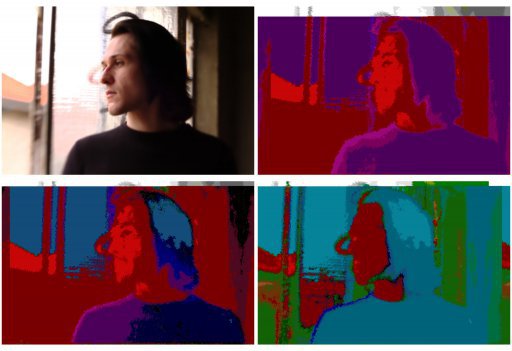
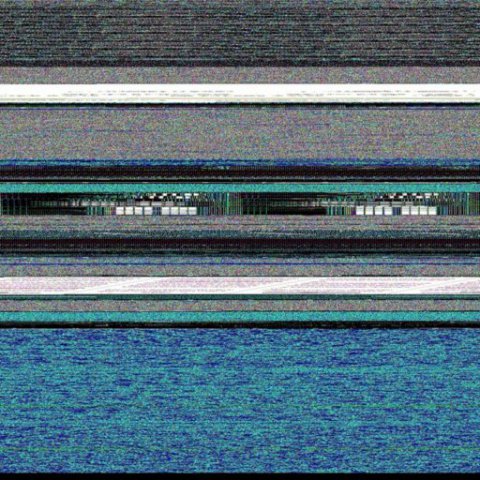
My third digital work is called Glitch-o-matic and is born of the reactions of the audience to my first two works. Reactions to the aesthetics of the video installation the synaesizer were very positive. F#555 was, meanwhile, appreciated for its participatory aspect. Glitch-o-matic combines these two aspects in a playful installation: ID photos cabin that "glitches" your portrait. This technique is however different from two other projects. Here, I use a particular form of glitch: the deliberate introduction of errors into a file.
The least visible aspect of my work is probably the fact that each of these works required specific program writing. I strive to do so using simple and older techniques which ensure that the scripts are easy to understand and can run on older machines. This also allows me to offer customized works: F#555 may use your data, the synaesizer turns your pictures into sounds and the Glitch-O-Matic introduces some fun errors in your passport photos. L:ED even offers digital installations and shows for all your events as well as dance, interactive projections, immersive installations...
I exhibit on MOAG because its approach corresponds to L:ED's
Christophe Dougnac Interview
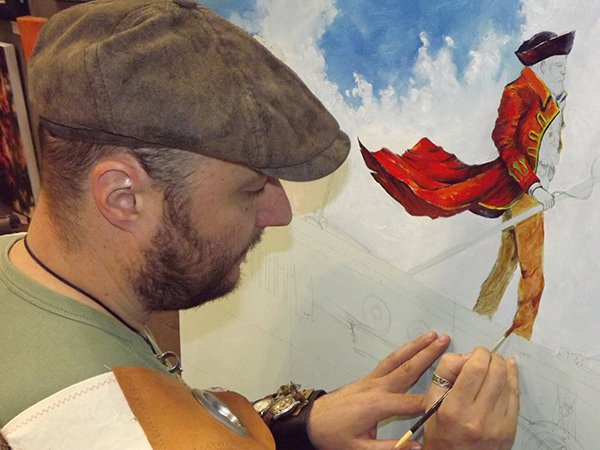
Do you belong to an artistic movement?
This is a tricky question. Today my work oscillates between traditional and digital techniques. As an artist, I would say I'm in two artistic movements: the digital painting and fantasy illustration. Beside, I am also author and editor of my books through crowdfunding platforms with a dedicated printer.
What is your main theme?
Fantasy! This allows me to create imaginary worlds populated by creatures and give me excuses to escape from the real world by keeping the head in clouds and feet on ground.
Did your style evolved?
My style has refined with experience; I tend to want to tell stories in a single image. Today, I master a dozen techniques.
I go through different stages of creations to get finished picture. Since the birth of the idea that often springs in my sketchbooks to exposed works, the path is as long as climbing a mountain.
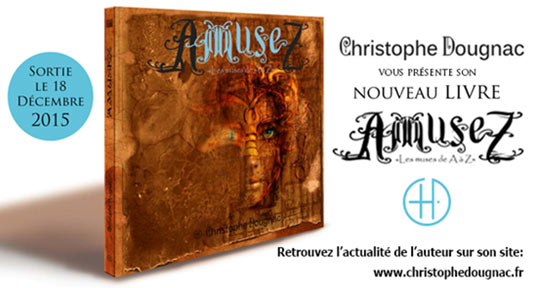
Your actuality
I have just finalized my last book AmuseZ which is an alphabet of imaginary and extraordinary muses. AmuseZ is a fiction, in opposition to current history books, where time is modified to make discover these celestial women who could inspire our future and enrich our culture. The imagination opens possibilities ranges and each woman reveals particular identity thanks to her beauty, her knowledge, her sacrifices. People can discover the participative campaign to launch this project:
What is your background?
Without falling into the famous "since always, when I was 8 I already drew ..." I would say that since 3 years, I am a painter and an author. My remains logical: School of Art and Graphic Design. I also developed my artistic skills through evening classes, internships and practice with various professional techniques. For 3 years, I participated in salons, festivals and exhibitions to present Krystoforos’ world. I also work on books retracing some of my collections.
What is your definition of an artist?
Being an artist means having the ability to appropriate tools to transform an idea into something that the public can see, feel, listen ... I think I have a realistic approach because even if I use different techniques, at the end, the result is not abstract.
What is art for you?
Art can be defined as an expression of thought, an inner dialogue toward the exterior. The art of fantasy realism is an imaginary message to the real or the reverse. In short, art is a world in our world. It is the fruit of a strange symbiosis between the complex personality of the creator and his environment.
I admit I do not always understand contemporary art. Yet it seems like there is a monopoly of artistic recognition in France. For me, construction of imaginary worlds is not different from the general thought or a child's universe, but a universe built with symbolic architectures and pareidolic characters, illustrating epic adventures allowing adults to regain their child imagination.
When passion became profession?
Since I was 15, I dreamed to make it my job. Only since the last 3 years my passion fed my job.
What inspires you?
I like to watch movies or read books (fantasy, adventure, science fiction ...). The more I look at the world of other fantastic artists, the more my imagination grows, creating bridges between my world and inspirations of the moment. I am often interested in art directors and illustrators by buying their artbooks and making-of which I use as personal culture.
I draw inspiration thanks to my travels. I do a lot of pictures to constitute a database in which I return later to develop my new illustrations. But my real motivation are the reactions of my family or the public in front of my new creations.
Have you always wanted to create?
The blank page syndrome never affected me. Today more than ever, I create every day and I would say that it is accelerating! My artistic and commercial agent made me a schedule of upcoming issues (books and collections that I develop). In addition, I teach drawing and painting. The more I teach to others, the more my universe grows.
Do you have a favorite format in the creation of your works?
Absolutely not. Instead, I diversify my collections and subjects that I approach. Because of narrative needs, I am using landscape and large formats more often.
Concerning digital works,it’s transport constraints which make me choose medium formats. I travel in Europe by car to exhibits in fairs and festivals. So, I am limited by the volume of the trunk.
What pleases you in exposing in 3D?
This can allow some people to better visualize my work in their interior.
Discover his creations: http://MyOwnArtGallery.com/artists/christophe-dougnac
Artists
Maria D. Rus
UNITED KINGDOM
Maria is a Romanian artist based in Wales, UK. She started to study Fine Arts 8 years ago in Romania, at the moment she is doing her MA in UK.
Paintings are for her more than a passion or a hobby, she is absolutely fascinated of this domain, considering it is a divine universe. She never stopped by experimenting as many as possible themes and techniques in order to discover her own style.
Her main themes are reincarnation and traveling through time. She uses herself as main subject to apply this experience on.
"If I would be supposed to describe my work in only one word, it would be metempsychosis."
+++
 David Vall
David Vall
FRANCE
David Vall was born in France in 1978. Even though graphite pencil drawing, Chinese ink painting and Japanese calligraphy were early artistic interests to him, he turned towards higher education in science and became a researcher in behavioural neurosciences. Two years spent in British Columbia led him to discover natural scenery and lights of rare emotional intensity that awakened interest in the magic of colours. His encounter with a Canadian painter made him to reconnect with drawing, but a few more years went by before the desire to try oil and acrylic painting grew and hatched. Painting is now a passionate and vital activity for him. His sources of inspiration are multiple: a piece of art he admired, the remembrance of scenery he contemplated, an emotion or a state of mind that holds on to his soul and wishes to take shape. Abstraction quickly became his preferred means of expression, allowing for incredible freedom, even if figurative themes can be chosen or suggested for specific orders. Knifes are preferred over brushes because they allow for a more structured work on materials, while permitting the introduction of random effects in shimmering and colour gradients. David Vall refuses any stylistic restraint, likes to explore varied techniques and textures, finds his inspiration into the work of artists he likes while developing his own pictorial approaches.
According to him, creativity is a set of experiences, memories and knowledge poured into the crucible of individuality, heated by emotions and extracted as a new and original form. Creativity, it is building connections, reformulating what already exists, inventing another reality or an abstraction upon what is known, what has happened and what has been lived. The human spirit does not create from void. It opens, gathers, and draws its inspiration from what is possessed.

More Background On MyOwnArtGallery.com
MyOwnArtGallery.com, often abbreviated as MOAG, was an innovative digital platform dedicated to showcasing and selling original artworks in a dynamic 3D environment. Designed to bridge the gap between traditional physical galleries and the digital revolution, MOAG offered artists a unique venue to reach global audiences, while simultaneously democratizing access to high-quality, original art for collectors and art enthusiasts.
Despite the eventual dormancy of the platform and the expiration of its domain registration, MyOwnArtGallery left behind a rich legacy of technological experimentation, artist empowerment, and cultural significance. This article explores its history, functionality, goals, artist community, exhibitions, media coverage, and lasting impact.
Origins and Vision
At its core, MyOwnArtGallery was founded with a compelling mission: to make art more accessible, immersive, and interactive using cutting-edge digital tools, particularly 3D environments. The founders, though not individually named in archived materials, were deeply committed to curating a space where the emotional and aesthetic experience of visiting a physical gallery could be recreated—and even enhanced—online.
“The Art world initiates its digital transformation because art lovers' habits have changed.” – MyOwnArtGallery
MyOwnArtGallery did not aim to replace physical galleries but rather to complement them by offering a virtual alternative that was borderless and always open. This approach was especially significant for emerging artists and art collectors without access to major art markets.
Key Features and Functionality
1. 3D Virtual Art Galleries
One of the most groundbreaking features of MyOwnArtGallery was its immersive 3D gallery system. Artists could select from various virtual gallery templates, each with customizable wall formats to simulate how a piece might look in a buyer's home or office. This “test before you buy” approach helped bridge the digital-physical gap and reduce buyer hesitation.
2. Artist-Centric Marketplace
MOAG was more than a gallery—it was a marketplace where:
-
Artists could register and exhibit their works for free
-
A 30% sales commission model helped sustain the platform
-
All artwork was certified as original or limited edition
-
Artists maintained creative control and autonomy
Artworks were offered in several formats:
-
Original Paintings (single artworks with certificates)
-
Framed Photographs (limited to 30 copies)
3. Personalized Commissions
Buyers could commission custom art pieces tailored to personal tastes, enabling deep connections between artist and client. All custom orders were delivered as unique pieces with accompanying authenticity certificates.
4. E-Commerce Integration
MyOwnArtGallery offered:
-
Secure payments
-
3-installment options with no extra fees
-
Worldwide shipping within 5 working days
This forward-thinking model anticipated many current trends in online art sales and fintech-enabled art e-commerce.
Artist Selection and Ethical Standards
Artists were not automatically accepted. They were chosen based on:
-
Talent and artistic merit
-
Innovation in style or theme
-
Respect for ethical codes defined by the platform
This emphasis on curation and quality control differentiated MOAG from other open-access art platforms. It also helped maintain a professional and respectful community of artists from around the world.
Notable Artists and Their Works
MyOwnArtGallery featured a global lineup of emerging and mid-career artists across various disciplines and styles. Some of the standout contributors included:
● Marc-Grégor Campredon (Ann Arbor, Michigan)
A professional photographer, Campredon used MOAG to showcase evocative images that walked the line between journalistic realism and poetic abstraction. His work emphasized the complexity of watermarking, digital rights, and artistic identity in the social media age.
“A watermark may prevent theft, but it won’t bring you extra business.” – M.G. Campredon
● Christophe Dougnac (France)
A digital and fantasy illustrator, Dougnac explored the tension between the real and the imagined. He was also an author and teacher, blending storytelling with technical prowess in both traditional and digital media.
● Maria D. Rus (UK)
Originally from Romania, Maria studied fine arts in Wales and used MOAG to present deeply symbolic works centered around reincarnation and temporal travel.
“If I had to describe my work in one word, it would be ‘metempsychosis.’”
● David Vall (France)
With a background in neuroscience, Vall brought a cerebral and emotional depth to his abstract paintings. He preferred knives to brushes, seeking texture and spontaneity in his works.
Community and Cultural Events
Geekopolis Festival
MOAG played a prominent role in the Geekopolis Festival, a celebrated Parisian event dedicated to imaginative and “geek” cultures. The platform provided a virtual gallery extension of the festival, housing digital artworks aligned with its five themed districts:
-
Heroic Fantasy
-
Fantastic Medieval
-
Science Fiction
-
Comics, Manga & Japanese Culture
-
Uchronia & Steampunk Worlds
These digital exhibits featured original artwork inspired by cultural icons like Batman and Jules Verne. Soundscapes and mini-games added layers of immersion.
L:ED Collective and Digital Experimentation
MOAG also collaborated with digital art collectives like L:ED, co-founded by artist Exomène. His data-driven installations, such as F#555, resurrected forgotten digital data from floppy disks and transformed them into music, images, and video art.
Technological Relevance and Impact
MOAG stood at the intersection of several digital trends:
-
Virtual Reality (VR) and 3D Immersion: Long before VR headsets became mainstream, MOAG provided immersive walkthroughs of art galleries via browser-based 3D environments.
-
Digital Democratization of Art: The platform's ethos aligned with increasing calls to dismantle elitist barriers in the art world. It offered visibility to underrepresented and emerging voices, regardless of geography.
-
Art as Cultural Archive: The preservation of exhibitions in digital form meant that the intellectual and emotional narratives of these events lived on even after physical shows ended.
“To lose the physical dimension of an exhibition is also to lose its content… Through the digital, [art] becomes permanent and universal.” – Julie Lesbats, Ecole du Louvre
Reviews and Audience Reception
Though formal reviews in traditional media were sparse, the response from participating artists and digital art enthusiasts was overwhelmingly positive. Testimonials on archived versions of the site highlight:
-
The platform’s ease of use
-
Its supportive community
-
Its transformative power in making art feel “alive and accessible”
Buyers appreciated:
-
The ability to test artwork scale and fit
-
The authenticity certificates
-
The option to purchase in installments
Artists appreciated:
-
Global exposure
-
Freedom from traditional gallery gatekeeping
-
Opportunities for collaboration and commissions
Broader Cultural Significance
MyOwnArtGallery.com operated during a period of major change in the art world—between roughly 2012 and 2016—when many institutions were just beginning to explore digital exhibition strategies. MOAG's proactive use of 3D, its international artist network, and its support for both traditional and experimental digital art positioned it as an early pioneer.
Its closing marked the end of a promising venture, but it left behind:
-
A visionary framework for how art can be exhibited and sold online
-
A network of artists who have since continued to develop their craft
-
A blueprint for integrating curation, commerce, and community
Decline and Dormancy
Despite its innovation and cult following, MyOwnArtGallery.com went offline after its domain registration lapsed. The last known social media activity occurred in 2016, and the site has since only been accessible via web archives.
One supporter, recognizing the importance of preserving its contributions, repurchased the domain to maintain a shell of the original content—an act of digital preservation that underscores the site's cultural significance.
Legacy and What’s Next
While MyOwnArtGallery.com may no longer be active, its influence continues in several ways:
-
Artists featured on MOAG have gone on to develop solo careers, publish books, and lead workshops.
-
The 3D art gallery model has been adopted by platforms like Artland, Kunstmatrix, and VR-allied spaces like Spatial and Mozilla Hubs.
-
MOAG’s values—artist-first commerce, immersive storytelling, and digital accessibility—remain at the heart of new art-tech ventures.
With continued interest in NFTs, metaverse galleries, and Web3 art spaces, MOAG’s early groundwork is more relevant than ever.
MyOwnArtGallery.com was a visionary and vibrant digital art hub that merged the emotional weight of traditional art with the technological tools of the 21st century. Through its curated exhibitions, immersive 3D walkthroughs, and global community of creatives, it succeeded in expanding access to fine art in ways previously unimaginable.
Though no longer active, its legacy remains a testament to what’s possible when art, technology, and community converge.
